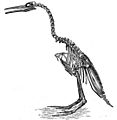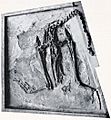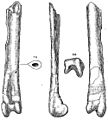Hesperornis facts for kids
Quick facts for kids HesperornisTemporal range: 89–65 million years ago: Upper Cretaceous
|
|
|---|---|
 |
|
| H. regalis skeleton in swimming pose; note feet pointing sideways. |
|
| Scientific classification | |
| Kingdom: | |
| Phylum: | |
| Class: | |
| Subclass: |
Hesperornithes
|
| Family: |
Hesperornithidae
|
| Genus: |
Hesperornis
Marsh, 1872
|
Hesperornis was an amazing extinct bird that lived a very long time ago, between 89 and 65 million years ago. This was during the Upper Cretaceous period, when dinosaurs still roamed the Earth!
Unlike most birds today, Hesperornis could not fly. Instead, it was a fantastic swimmer, spending its life in the water.
Scientists learned a lot about ancient birds from Hesperornis. It was first found by a paleontologist named Othniel Charles Marsh in the late 1800s. This was during a time called the "Bone Wars," when scientists were racing to discover new fossils.
Many Hesperornis fossils have been found in places like Kansas (USA) and Canada. These areas were once covered by ancient seas. It's thought that Hesperornis lived all over the northern parts of the world.
Contents
What did Hesperornis look like?
Hesperornis was a big bird, growing up to 1.5 meters (about 5 feet) long. Imagine a bird as tall as a person!
It had tiny, almost useless wings. But its strong back legs were perfect for swimming. They were like powerful paddles.
One super cool thing about Hesperornis was that it had teeth in its beak! Most birds today don't have teeth. Hesperornis used its teeth to grab slippery prey, probably fish.
Where and how did Hesperornis live?
Hesperornis hunted in warm, ancient seas. These seas were like huge inland oceans, such as the Western Interior Seaway in North America. The water back then was much warmer than it is today, like a subtropical or tropical climate.
These birds likely ate mostly fish. They might also have eaten crustaceans (like crabs) and cephalopods (like squid). Their teeth were very helpful for holding onto these slippery or hard-shelled meals.
How did Hesperornis move on land?
Because their legs were so far back on their bodies, Hesperornis probably couldn't walk well on land. They definitely couldn't stand upright like penguins.
Scientists think they might have moved by sliding on their bellies. Or maybe they just waddled very clumsily. Their bodies were perfectly built for diving and swimming, not for walking. We don't know much about how they laid eggs or cared for their young on land.
Young Hesperornis grew up quickly, just like modern birds. More young bird fossils have been found in northern areas. This suggests that some Hesperornis species might have traveled, or migrated, to different places during the year, similar to how some penguins do today.
Hesperornis was sometimes hunted by large sea creatures. For example, scientists found Hesperornis bones inside the stomach area of a huge marine reptile called a mosasaur.
Images for kids
See also
 In Spanish: Hesperornis para niños
In Spanish: Hesperornis para niños








